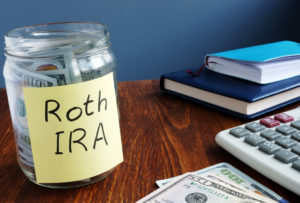Financial Advisors
why I love the Roth IRA. I also love the Solo 401(k). If you're looking for another way to save for retirement, you want to check out these Solo 401(k) benefits.
What is a Solo 401(k)?
But first, it's important to understand what a Solo 401(k) is. Also known as an individual 401(k) or solo-K, a Solo 401(k) is a tax-sheltered retirement account for really small businesses–just you in fact. This two-part series will discuss the solo-K in the context of having a main job (w2) and having a side job with 1099 income, such as moonlighting, a blog, completing medical surveys, etc. Although, the benefits will also apply if you have 1099 income alone as well. With a really small business, you are considered to be both the employEE and employER.
What Are The Solo 401(k) Benefits?
Like all retirement accounts, it pays to really understand what you're signing up for. If you found yourself nodding along to the criteria above, you're in luck. You could start reaping all the benefits of a Solo 401(k) right away. Here's what to love about them:
Benefit 1: Ability to contribute up to $56K*
You're limited to a maximum $19K employEE contribution through your work-sponsored 401(k)/403(b). The IRS allows your employer to make additional “profit-sharing” contributions of $37k for a total of $56k. Unfortunately, while many of us have employer “matches”, we don’t work for employers with profit-sharing plans. But if you open a solo-k for your small business, you can make both employEE and employER contributions up to the current max of $56K. Keep in mind that if you have multiple work 401(k)s, you're limited to one $19K employee contribution across all accounts. But you can make “profit-sharing” contributions of 20% of net income to your solo-K even if you’ve contributed $19k as an employEE. Like regular 401(k)s you can elect pre-tax (or traditional) employee contributions or after-tax, or Roth contributions. Employer contributions are always pre-tax.
Benefit 2: Ability to hire your spouse
This is a great perk if you have a stay at home spouse who would only have access a spousal Roth IRA. Hire your spouse and s/he will be able to contribute $18K as an employee. Win-win
Benefit 3: Ability to roll over other retirement accounts into it
This is huge. As life goes on you'll change jobs at least a few times. This often leaves a trail of “orphan” 401(k’s)/403(b’s). You may have rolled over one or more of these into an IRA or two. It can get really messy. Not to mention that you're probably paying a maintenance fee for all of the accounts. Set up a solo-K and you can roll all these orphans into it, consolidating everything into one account. Less paper, less emails, and easy to keep track of your investment plan. It's retirement account decluttering at its best.
Benefit 4: Ability to contribute to a backdoor Roth IRA without being subject to the pro-rata rule
After you move all your old accounts (namely, anything with “IRA” in the name), you now have a clean slate to begin contributing to a backdoor Roth IRA. If you have any other non-zero balances in any IRA account, you’ll be subject to the pro-rata rule if you contribute to a backdoor Roth IRA, which means you’ll pay unnecessary extra taxes. Not good. You're convinced you need one now, right? I thought so.
While the Solo 401(k) benefits probably have you ready to open an account, there are a few other questions worth addressing first.
Can I open a Solo 401(k)?
Maybe or maybe not. You need earned income, typically as an independent contractor (IC). If you own an S-corp with no employees, this would come from your W2 income. For physicians, however, this is typically IC income from moonlighting, income from surveys, speaker fees, etc. If you don't have any of these now, you can find this kind of work pretty easily.
I only made $1000 of IC income. Is it worth opening a Solo-K?
Yes and yes! You need only the minimum a custodian (aka brokerage firm) requires to open a solo-K. There are no “required minimum” contributions to make to a solo-K. It is worth opening for the ability to roll over other retirement accounts into it (see #4 above).
What else do I need to know about Solo 401(k) plans?
- Once the balance in the solo-K reaches $250K you'll be subject to some compliance measures including filing form 5500 with the IRS annually.
- You need to open the solo-K by 12/31 of the calendar year but you'll have until tax day, including extensions, to fund it. So the absolute latest you can fund it is by 10/15 the following year.
Final Thoughts on Solo 401(k) Benefits
If you're feeling like you haven't arrived yet with your 1099 income, remember that you don't have to make huge contributions to start a Solo 401(k). Savings and retirement are all about options. Giving yourself access to another way to save for the future is priceless.
Read on for the second part of this topic where I'll discuss why you should choose a solo-K over a SEP-IRA and where you should open your Solo-K.
*2019 limits. If you are age 50+, you can add another $6k to your employee contributions.
Read More Last month I spelled out how we are investing our money in 2017. I mentioned there were some moving parts – namely, M was unemployed and we knew, at the time, that I was (newly) pregnant. Now, M has a job (yay!) and looks like this pregnancy will stick, so now we can do some real projections for 2017. Our asset allocation will remain the same.
 This year our total “retirement” contributions will consist of:
This year our total “retirement” contributions will consist of:
- $18,000 my 403(b)
- $20,800 employer match + contribution into my 403(b). Currently 20% vested. 40% vested as of August 1, 2017 so actually $8,320
- $18,000 my 457(b)
- $5,500 my Roth IRA
- $18,000 his 403(b). No matching at this time
- $11,000 his Roth IRA (his first! For 2016 and 2017)
- Other sources:
- A very modest amount ~$1,000 into my solo-401(k). Yes this blog likely won't lose money this year 🙂
- ~$5,000 his solo-401(k) – he has some 1099 income this year
whole start-up planning phase, but we have decided what our asset allocation will be and what our accounts are.
You'll see how I invested my money last year here, but in summary:
- 55% US stocks:
- VIIIX: Vanguard Institutional Index Fund Institutional Plus Shares 0.02%
- VIEIX: Vanguard Extended Market Index Fund Institutional Shares 0.12%
- 20% International stocks:
- VFWSX: Vanguard FTSE All-World ex-US Index Fund Institutional Shares 0.11%
- 10% Small cap value:
- VISVX: Vanguard Small-Cap Value Index Fund 0.2%
- 8% REITs:
- VGSIX: Vanguard REIT Index Fund Investor Shares 0.26%
- 7% Bonds:
- VBMPX: Vanguard Total Bond Market Index Fund Institutional Plus Shares 0.05%
Now there is a “we”, and we have decided to follow our FP's advice to go 100% equities to maximize growth. We moved all of M's 4 accounts (mix of old work IRAs, 401(k)s into one solo-401(k) at TD Ameritrade. He had 1099 income in 2016 and the solo-K was opened in December 2016. TDA allows Roth 401(k) so we opted to make his 2016 contributions Roth (small amount though since his 1099 income wasn't substantial). He had a small amount contributed to his W2 job's 401(k) in 2016 but he became unemployed relatively early in the year. He also contributed to a Roth IRA for 2016 (his first time) as well this year, and he'll do 2017 in short order.
I'm still doing what I did last year – contributing the full $18,000 each to the 403(b) and 457(b) and $5,500 to a Roth IRA (already funded for 2017). I also have the option to do the “Mega Backdoor Roth IRA” (to be covered in a future post), but have not gone there yet. We don't have a taxable account (yet). Our IPS with our FP has the following asset allocation:
- 68% US stocks
- 17% Large cap growth, 17% Large cap value
- 17% Small cap growth, 17% Small cap value
- 24% International stocks
- 12% Large cap developed countries
- 12% Diversified emerging markets
- 8% US REITs
You'll see that it's not that different from my original, with the subtraction of bonds. There is no mid cap category since mid caps are a fuzzy category. In M's solo-401(k), the details are:
| iShare Core S&P Small-Cap | 17% | IJR |
| Vanguard Dividend Appreciation ETF | 17% | VIG |
| Vanguard FTSE Developed Markets ETF | 12% | VEA |
| Vanguard FTSE Emerging Markets ETF | 12% | VWO |
| Vanguard High Dividend Yield ETF | 17% | VYM |
| Vanguard REIT ETF | 8% | VNQ |
| Vanguard Small-Cap Growth ETF | 17% | VBK |
This account is managed by our FP. I still manage my work's 403(b) and 457(b) and I'm still managing my Roth IRA at Vanguard, but I may let them manage the Roth IRA at some point. I also plan to open up my own solo-401(k) this year. My allocation is a little bit different than what our IPS states but not too far off:
| Vanguard Institutional Index Fund (large caps) | 40% | VIIIX |
| Vanguard Extended Market Index Fund (small & mid caps) | 20% | VIEIX |
| Vanguard FTSE All-World ex-US Index Fund | 12% | VFWSX |
| Lazard Emerging Markets | 12% | LZEMX |
| Vanguard Small-Cap Value Index Fund | 8% | VSIAX |
| Vanguard REIT Index Fund | 8% | VGSIX |
The small cap and REIT funds are in my Roth IRA. The rest are in my 403(b) and 457(b). We will rebalance the accounts once a year. We have not fully decided how much we will put away for investments this year at this time. There are some moving parts right now making it challenging to project how much we will be able to put away outside of maxing out available tax-advantaged retirement pots.
What is your asset allocation for 2017?
Read MoreMonet's lilies @ Musée de l'Orangerie, Paris, France[/caption] This is a very frequent question and topic on the finance blogs. I like how the White Coat Investor made a nice and easy to follow order of things. Basically pay off any consumer debt and other high interest loans first. Then he prioritizes saving for retirement over lower interest loans. Then in this post he says most docs should have their loans paid off within 5 years of graduating. I've struggled with how fast I should be paying off my student loans. If I really wanted to, I could wipe them out in 3 years (possibly less with bonuses) but would require more than a decent amount of sacrifice. How awesome would it be to be student loan free in < 3 years? I've changed my mind countless times about this. At least I was maxing out all of my available tax-advantaged accounts while flip-flopping. Currently, I fully fund my job's 403(b) (+ generous employer contribution), 457(b), and a backdoor Roth IRA. This amounts to $62,300 this year. I don't have a taxable account yet. I think for the average physician (although even this definition is quickly changing) who becomes an attending physician around age 30 (and funded a Roth IRA during residency) the WCI's general plan is a good one to follow. For folks like me however, who became an attending much later in life (38)- I've lost valuable time. Remember, time is a huge part of how compound interest works. If you have less time, then you need more money (saved) to make up for it. The same could be said for folks who have children and other priorities that require money. This late in the game, brute savings is what will get me to financial independence. Instead of the suggested 20% saved for docs, I need to save at least 30%. I recently took advantage of First Republic Bank's amazingly low interest rates for student loan refinancing. This forced me into a 5 year maximum pay off period with a fixed interest rate of 2.25%. I'm ok with that. I also have another $80K loan with my mom and will pay this off in < 5 years. What am I doing with my “extra” cashflow? Saving. We hope to start a family soon and will need to pay for childcare and the kid him/herself. NYC daycare can be between $2,000-$3,000 a month easily! We also need to beef up our emergency fund with more at stake. M and I have picked $5 million as our FI number. We probably don't need that much. I prefer to save more, just in case, to be prepared for medical costs, possible long term care etc. Picking $5 million puts us in the position to help our children and our parents too if need arises and still remain secure. We want to get there in 20 years (2037) or less. Not a small feat. The first milestone – the first million – is set for June 1, 2023. I'll let you know how that's going year to year. What do you think? How fast are you paying off your loans? Have you picked your FI number? Comment below.]]>
Read MoreIf you work for a large healthcare provider, you may have access to a 457(b) retirement account in addition to a 401(k)/403(b). Are you using it? Maybe yes, maybe no. You might want to use your hospital's 457(b).
Here's why:
The Benefits of Your Hospital's 457(b)
- Tax benefits! With your hospital's 457(b), you can invest an additional tax deferred $19,000 annually (in 2019). This escalates to $24,000 annually if you are over 50. Why do this? This lowers your taxable income. Like a 401(k), you pay income tax when you withdraw. Some 457(b)s even offer a Roth option.
- Flexibility! In addition, you can withdraw this money before age 59.5. This is great if you are planning early retirement. Why? Unlike the 401(k)/403(b)/and most IRAs, you'll have access to your money earlier.
Understanding The Types of 457(b)s
There are 2 types of 457(b)s and it's important to know which type your employer offers. There are governmental (or public) and non-governmental (or private) 457(b)s.
Governmental 457(b) Options
If you have a governmental 457(b), this is a “no-brainer”. You should use it if you need more tax advantaged space to save in. Of course, this also depends on if the plan costs and fund choices are agreeable. Public 457(b)s can be rolled over into an IRA or 403(b)/401K(k) when you leave the job.
Private 457(b) Options
Private 457(b)s are different story. The money you deposit technically belongs to your employer and can be used to pay off employer's creditors. This is only an issue if your hospital goes under. A good way to see if your hospital is afloat is to check their credit rating. I know this sounds scary but as far as I know, no one has lost their 457(b).
Exploring Your Hospital 457(b) Plan Options
The next step is to find out what the distribution options (if there are any) are when you leave the job.
Some plans make you take out one lump sum on separation. This is a lousy option, and I would hesitate using it.
You want multiple options. Preferably, you can defer distribution until retirement age and take money over time to control your taxable income. The main “con” of a private 457(b) is that you can only roll it into another private 457(b). Another catch is this. Your new private 457(b) would have to accept rollovers, and they don't have to.
Your best bet is to always get a copy of your employer's 457(b) plan as details can differ widely.
Final Thoughts on Your Hospital's 457(b) Plan
A 457(b) is a way to have access to your money before age 59.5 besides a taxable account
Your retirement savings plan should include different types of accounts to diversify. A 457(b) is a way to have access to your money before age 59.5 besides a taxable account.
I am using my hospital's private 457(b) account. I almost maxed it out last year ($16K) and will be maxing it out this year. My 457(b) plan is low cost and has a limited fund list but does include some basic Vanguard funds. Fortunately, the distribution options are very flexible so upon leaving this job, I can defer distribution until retirement age.
Since this post went live, I left the hospital job. I chose to cash out my 457(b) despite being able to leave it there indefinitely. Why? I wanted total control over the money. Yes I paid income taxes on it. I promptly deposited the check into my Vanguard taxable brokerage account. With the changing and unstable landscape of medicine, I do not want to depend on the hospital staying afloat.
No matter where you are in your career or where you are on your retirement journey, inquire about your 457(b) plan that your hospital offers. You might be able to get your hands on some serious tax-time benefits and add more flexibility to your retirement plan.
Does your job offer a 457(b)? Do you use it? Why or why not?
Read MoreThere is a lot of confusion about Roths – Roth IRAs, Roth conversions, Roth 403(b)s and Roth 401(k)s. They are all different but share a common theme – tax-free growth and tax-free income on withdrawals. Who is this Roth person anyway??
I'm going to mainly focus on Roth IRAs here. The Roth IRA is a tax-advantaged retirement vehicle where a person can contribute $5,500 ($6,500 if age 50 and over) per year. The contribution is with after-tax dollars. Once inside the Roth IRA, the money grows tax-free and is not considered income when you withdraw the money – so it is tax-free on withdrawal.
I love the Roth IRA because:
- No RMDs (required minimum distributions). If you die and your spouse inherits your Roth IRA, still no RMDs. All other retirement accounts, including the ones with the word Roth in it are subject to them.
- You can open one for your spouse, even if she/he does not have earned income
- Not part of the taxable estate
- You can still contribute to it after age 70.5 if you're still working whereas you can't after that age to a traditional IRA.
The only major con of Roth IRAs is that you don't get an immediate tax break on the contribution. It is also possible that congress may decide to tax these accounts or place a limit on how much can be in a Roth IRA.
You may have heard that once you make over a certain amount that you can't contribute to one (in 2017 – phase out starts at $118K single, $186 married filing jointly). There is a loophole to get around this. You contribute $5,500 to a non-deductible traditional IRA (TIRA), wait 1-2 days, then “convert” it to a Roth IRA. It is legal. BUT, and this is a big but, you cannot do this without tax consequences if you have have a non-zero balance in any other IRA accounts (traditional IRA, rollover IRAs from prior 401(k)s, SEP-IRA). It's called the pro-rata rule. There are easy ways to zero out these accounts to take advantage of the backdoor Roth IRA:
- If you have a non-deductible (after-tax) TIRA, you can convert the entire account to a Roth IRA and pay taxes on the gains only.
- If you have a pre-tax IRA, including a SEP-IRA, you'll need to roll this into a 403(b), 401(k) or ideally a solo-401(k). You need 1099 income to open a solo-401(k).
Here is a great step-by-step tutorial on how to do the backdoor Roth IRA. If you have your Roth IRA at Vanguard, then look at this guide by PoF. My Roth IRA is at Vanguard and currently contains a REIT (VGSIX) and Small-Cap Value fund (VSIAX). Due to the tax free growth & withdrawal you'll want to put in more aggressive and/or less tax-efficient funds in here.
Backdoor Roth IRAs are often confused for Roth Conversions, especially since the backdoor Roth IRA includes a conversion from a TIRA to a Roth IRA. Roth conversions is a strategy to convert pre-tax retirement accounts (deductible TIRA, 401(k), 403(b)) to a Roth IRA. Then this money has the same benefits of being inside a Roth IRA above. The downside? You pay taxes on it at your marginal rate. You do Roth conversions in a low income year like the year you retire.
Read MoreFirst, a bit of (short) investing history.
I invested $1,000 into a Roth IRA during my third year of residency (2015). This account is at Vanguard and I initially invested all of it in their 2045 Target Retirement Fund. I had no idea how to invest my money but I knew that Vanguard was a good place to start.
My first (and current) attending job (started September 2015) gave me access to a 403(b) and a 457(b) plan. They have a limited fund list, but have some low cost Vanguard funds. Again, I still had no idea how to invest, but luckily, they automatically selected a Vanguard Target Fund based on your age. I managed to contribute close to $16K for 2015. I did not really understand what a 457(b) was and read some “bad” things about it, so I decided to figure that out later.
In 2016 I maxed contributions to the 403(b) ($18,000) and started receiving a generous employer match (about $16.5K in 2016). Takes time to fully vest but I am currently 20% vested. I almost maxed out the 457(b) plan as well – about 16.5K (more in an upcoming post about how and why I ultimately decided to use this). I also funded both my 2015 and 2016 Roth IRA via the backdoor, although I fell a little short for my 2015 contribution at $4,000.
I read more about index funds and how to create an asset allocation. After tinkering with things a few times, I finally “set it and forget it:”
- 55% US stocks:
- VIIIX: Vanguard Institutional Index Fund Institutional Plus Shares 0.02%
- VIEIX: Vanguard Extended Market Index Fund Institutional Shares 0.12%
- 20% International stocks:
- VFWSX: Vanguard FTSE All-World ex-US Index Fund Institutional Shares 0.11%
- 10% Small cap value:
- VISVX: Vanguard Small-Cap Value Index Fund 0.2%
- 8% REITs:
- VGSIX: Vanguard REIT Index Fund Investor Shares 0.26%
- 7% Bonds:
- VBMPX: Vanguard Total Bond Market Index Fund Institutional Plus Shares 0.05%
I hold the small cap value and REIT fund in the Roth IRA. The rest are in the 403(b) and 457(b). I have yet to open a regular old taxable account.
How did I do? Well, turns out it's not that easy to really know:

This is a screenshot from Personal Capital. I use this to get a nice “overview” of my investments and it has some nice graphics and tools to play around with. On the upper left you'll see the “You Index.” This is NOT the actual portfolio performance though, it's the performance if you had held your funds from the starting point of the graph. It's still useful as a rough guide though. You'll also notice that the S&P 500 finished at 9.54%, but this doesn't take into account dividends re-invested. The S&P 500 finished at 11.96% with dividends re-invested.

This is a screenshot from my 403(b) plan. 17.59% ! But I checked this on 1/9/16, so it's not exactly all of 2016 but close enough. My 457(b) returned 8.4%. My Vanguard account's return was 11.8%. My best guess is that overall, based on portfolio % (the bulk of my money is in my 403b), I clicked in around 14%. But the range is probably 13-15%. Not bad for a very new investor.
My allocation will likely change in 2017 (planning on getting rid of the bonds, for example) and I'm going to switch to ETFs in the Vanguard account.
Read More- « Previous
- 1
- 2









